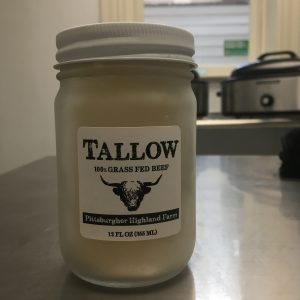 Tallow is made by rendering suet which is the fat of cattle or sheep, typically the fat that surrounds the animals organs. The process of rendering involves gently heating suet to separate the fat from any remaining muscle or connective tissue. The result is a pure fat that once cooled, is solid at room temperature.
Tallow is made by rendering suet which is the fat of cattle or sheep, typically the fat that surrounds the animals organs. The process of rendering involves gently heating suet to separate the fat from any remaining muscle or connective tissue. The result is a pure fat that once cooled, is solid at room temperature.
Tallow has been used in a variety of ways throughout history. Primarily, tallow has been used in traditional food preparation – as an ingredient and as a cooking oil.
It has been used in cooking, for making soap, candles, as a healing salve and skin balm as well as a lubricant for wood, leather and metal working industries. The advent of petrochemicals and other industrially produced oils replaced this traditional oil in many of these industries.
McDonalds cooked their fries in tallow until 1990 because at that time it was believed that saturated fat causes heart disease, a theory that has more recently been debunked. They switched to polyunsaturated oils including corn, soy and cottonseed oils all of which are industrially produced and required significant chemical processing.
Recent studies have proven that natural fats including tallow, lard and butter do not cause heart disease and other health conditions but in fact are health promoting and are part of a healthy diet.
The most common use of tallow is as a cooking fat. This is because it has a high smoke point (420°) which means that it can withstand high cooking temperatures without oxidizing and becoming rancid.
It is also commonly used as a balm, salve or cleanser for skin. Because grass fed beef tallow contains fatty acids in a similar proportion to human skin, it is easily absorbed. It is particularly healing for rashes and other inflammatory skin conditions as well as cuts and scrapes. It is antimicrobial, antifungal and anti-inflammatory.
Grass fed beef tallow contains the fat soluble vitamins A, D, E and K which are only found in animal products and are necessary for health. These nutrients contribute to hormonal, neurological and cardiovascular health as well as bone and muscle growth and immune function.
Tallow from grass fed beef is also an excellent source of Conjugated Linoleic Acid, a powerful anti-inflammatory, antioxidant which is also an effective fat burner. Finally, it contains a beneficial ratio of Omega 3 and Omega 6 fats. Both are essential because unlike other fats, our body is unable to make them. A ratio of O6 to O3 of less than 4 is considered ideal (but the closer to 1, the better. Tallow from grass fed beef has a ratio of approximately 1.4 whereas that of grain fed (conventional) beef is closer to 8.
Use tallow to cook at high heat, and as a replacement for vegetable and other industrial oils in recipes. You can also use tallow to soothe dry skin and heal skin infections. You could also try making soap and candles with this ancestral fat!